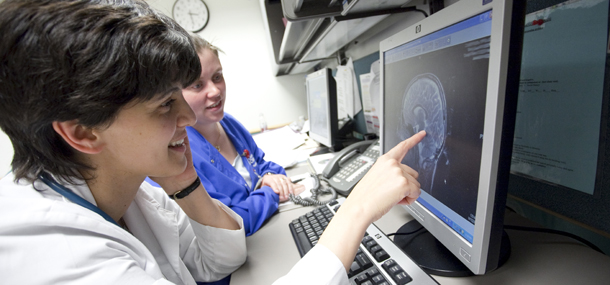
“A 5-year-old with headache, vomiting, and double vision” are words that may prompt a doctor to order a brain MRI. Luckily, most brain MRI exams with this indication end up being normal; however, we sometimes unfortunately identify abnormalities that lead us to the diagnosis of Diffuse Intrinsic Pontine Glioma (DIPG) .
DIPGs are tumors that occur in the pons, a part of the brainstem on the lower back of the brain near the top of the spinal cord. Typically these tumors occur in children 5-7 years of age, although they may also be found in older children and some adults. You may have recently seen the story of Lauren Hill, a young woman who has made international headlines for her courageous efforts in increasing awareness of this disorder. About 150 new cases are diagnosed in the US each year, and despite much research, fewer than 10% of children with DIPG survive longer than 2 years from diagnosis.
Due of the relatively small numbers of DIPG patients seen at any one institution, it has been difficult to compare treatments and share experience about this devastating tumor. Recently, under the leadership of Dr. Maryam Fouladi at Cincinnati Children’s, an international DIPG Registry has been created to collect clinical information, imaging studies, and tissue samples (all samples and images are anonymous) from multiple institutions throughout the US, Canada, and Europe. Cincinnati Children’s is the coordinating center for the registry and all imaging studies and pathology data will be stored and reviewed at the hospital. The Department of Radiology has donated the use of its advanced Research Imaging Archive for use in the registry.
“Previous studies have not been very successful in showing a relationship between imaging findings, treatment response, and survival in DIPG,” says Dr. James Leach, a radiologist. He’s been involved in reviewing the imaging on more than 300 patients already enrolled in the registry and 500 more committed over the next year.
“We feel that with a careful analysis of a large number of patients, we can begin to see trends in imaging that may indicate which patients may respond to different therapies,” says Dr. Blaise Jones, the other reviewing radiologist at Cincinnati Children’s. “This may lead to better treatment strategies that can improve the outcome for these kids.”
Along with Drs. Jones and Leach, Dr. Alisa Kanfi, a neuroradiology fellow, presented the initial DIPG evaluation results at the American Society of Neuroradiology (ASNR) and European Society of Paediatric Radiology (ESPR) meetings in 2014. The registry continues to enroll subjects.
Contributed by Dr. James Leach.